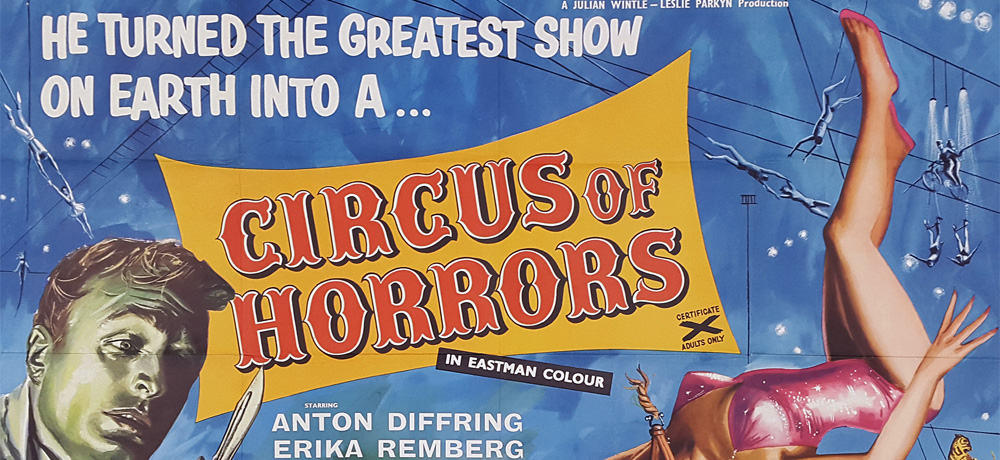


No one goes to the circus anymore. Outdated, antiquated, and cruel, it houses and mistreats animals for our amusement; I’d sure like to see the people running it tortured instead of the animals. Speaking of which, Circus of Horrors (1960) does just that; the circus is an ideal setting for shadowed deaths and “unforeseen” accidents, and this film provides plenty while still retaining a solid focus on its characters.
Released by American International stateside in August, with a slight earlier date (late June) by Anglo-Amalgamated on its home turf of the UK, Circus of Horrors was well received by some critics, who praised its sturdy direction, potent atmosphere, and strong performances. Audiences dug it too, especially in the states, where it double billed with The Angry Red Planet and did quite well. Even if it hadn’t performed, it’s still a fast-paced thrill ride through the grimy and tattered tents of the big top.
We open in England, 1947; with the war over, German plastic surgeon Dr. Rossiter (Anton Diffring – The Man Who Could Cheat Death) is free to perform his experimental reconstructive facial surgery. But when an operation goes wrong on a female client, Rossiter and his assistants, brother and sister Martin and Angela (Kenneth Griffith and Jane Hylton), flee for France and come upon a fleabag circus run by Vanet (Donald Pleasence – all the horror films). Changing his name to Schuler, he offers to repair Vanet’s daughter Nicole’s face, in exchange for co-ownership of the circus. That isn’t hard to arrange as it turns out; one of Vanet’s bears mauls him to death while in a drunken stupor. (Vanet was drunk, not the bear. Although…)
Ten years pass, and Schuler’s circus is the talk of Europe; very successful, it has also earned the nickname “Jinx Circus”, because several “accidents” have befallen the beautiful women who work there. The reason? Schuler looks for facially deformed women – either criminals or victims – to fix then hire; when the women no longer want the life (or him), he ensures that they cannot leave. As the circus makes its way back to England, Scotland Yard still has the Rossiter file open, and a certain someone fits their profile…
Circus of Horrors arrived as the censors were starting to take a bit of starch out of their collars; not that this production pushes any particular boundaries or introduces new cinematic taboos, but it certainly kept abreast with the changing social tide of the time. So ye of faint heart, please note: there are scantily clad women, and blood shall be spilled (just not enough that it couldn’t show on the Saturday afternoon movie). But it (usually) isn’t enough to throw the scraps to the audience; sometimes they want a little more meat in their diet.
This isn’t to say that Circus of Horrors is a treatise on the wages of war or its crippling psychological aftermath; while the film does pay lip service to the notion - little Nicole had stepped on a landmine and became disfigured – it offers little in the way of political discourse. (Perhaps in another, more artful film.) The focus here is the characters, especially the relationships between Schuler and his lovely protégés, which deal in quantity over quality it seems. (Schuler is a finicky sort.)
Of course, all of the troubles stem from Schuler (played with icy cool by normally Nazi baddie Diffring) and his cockeyed idealism – he likes to help people until they no longer reciprocate, then he kills them – which does give our antagonist some depth, even if there is very little “good” to combat it. Circus of Horrors flies above the crowd with its meanness and nihilism; there isn’t an ounce of post-war optimism on display.
And dammit, why should it? This is horror my love, and if evil is to be vanquished, first it must be witnessed. Schuler acts as his own Grand Guignol “Phantom” figure, lurking in the shadows to kill, deploying missteps for his high-wire mistress, his lion tamer, and his knife thrower’s assistant. No, any joy to be gleaned lies solely in the destruction of Schuler; and his last act downfall is glorious, if a bit harried.
Circus of Horrors was a great warm up for director Sidney Hayers and writer George Baxt; their next outing together, Burn, Witch, Burn (’62) is less lurid yet also spectacularly atmospheric, much like this one. Filmed in “Specta-Color”, another great nothing gimmick, Circus’ decadence and perversion of innocence is captured, between the grime of the dirt floors and the colorful suffocation of the big top. (I don’t like enclosed spaces, okay?) Burn is better simply due to its latent subject matter (the subjugation of women and their roles in society), but Circus of Horrors doesn’t shoot for those lofty ideals, so it must be judged on what it does do well: 88 minutes of fast-paced mayhem under the bright lights, well acted and slickly made. I may not be a fan of the institution, but that doesn’t mean I can’t like the films that dance under the spotlight.
Circus of Horrors is available on Blu-ray from Scream Factory.
Next: Gialloween 2020: Drive-In Dust Offs: THE BIRD WITH THE CRYSTAL PLUMAGE (1970)